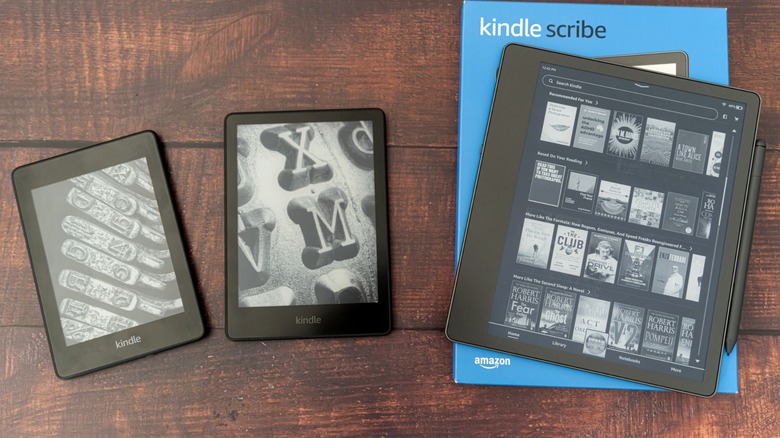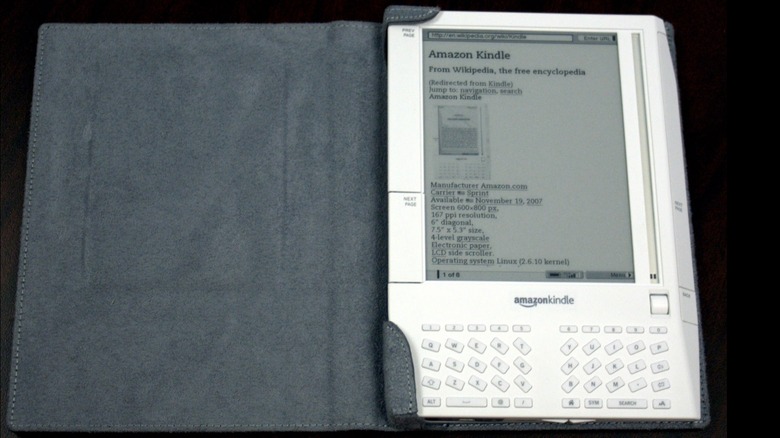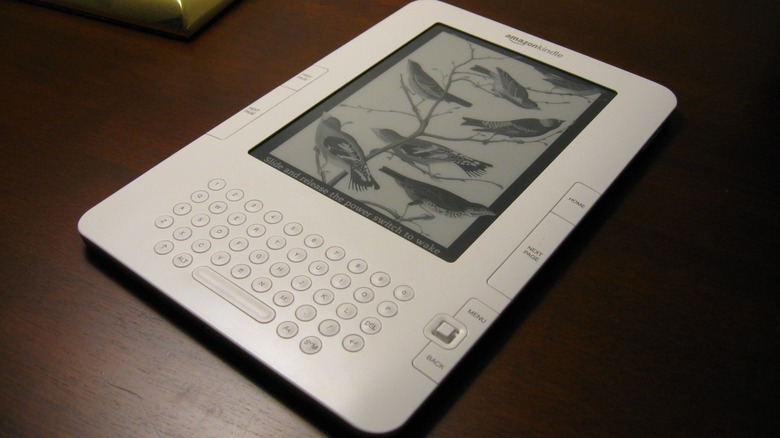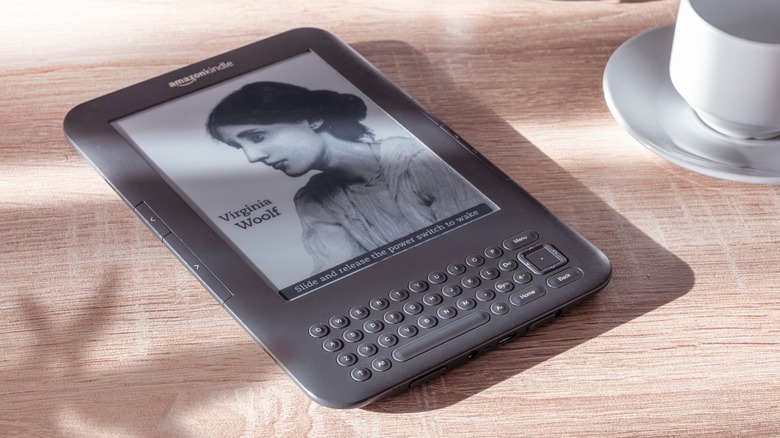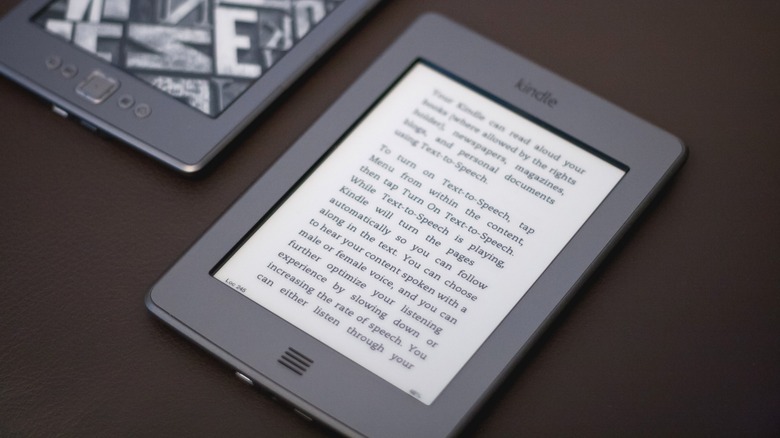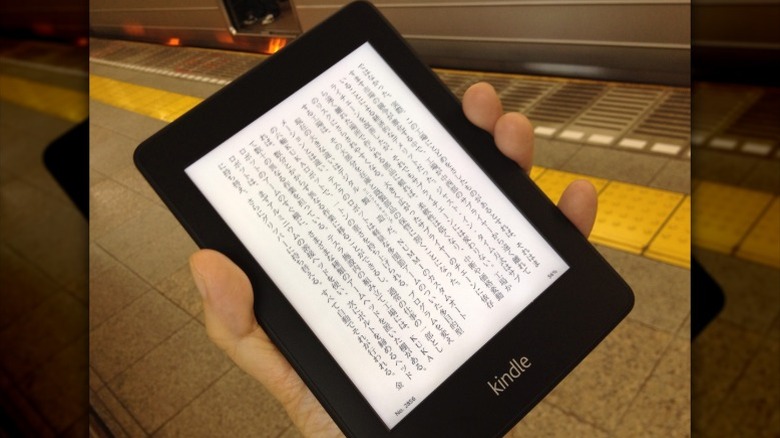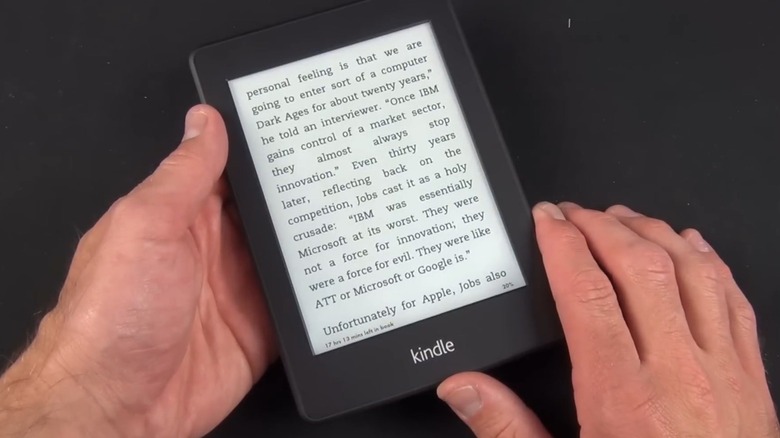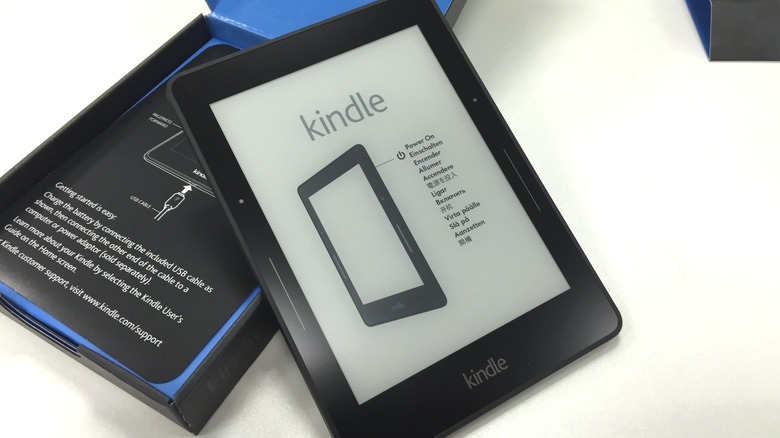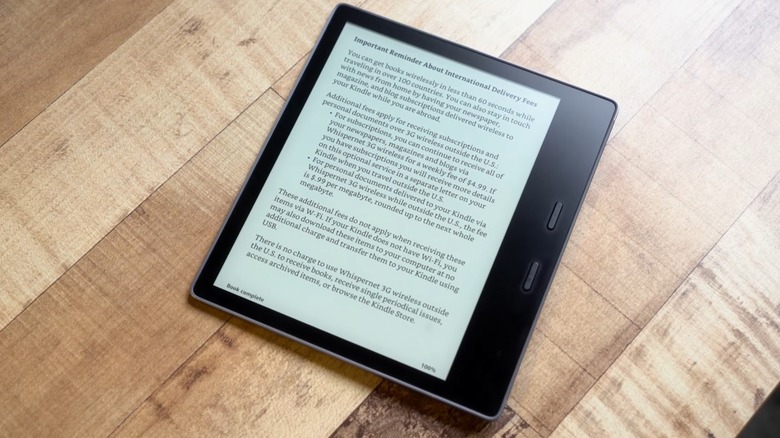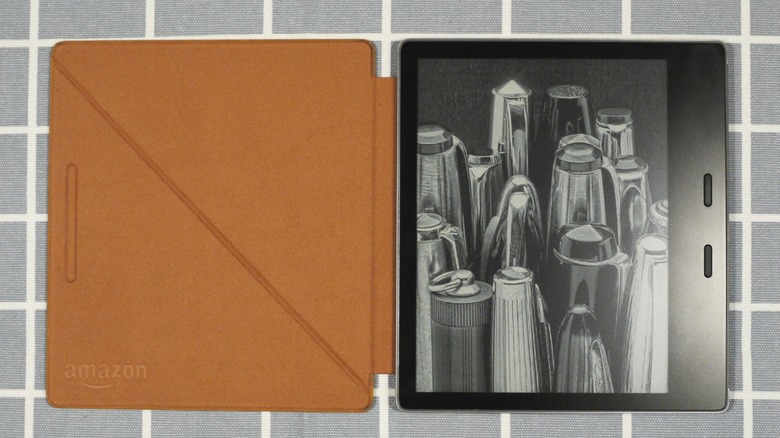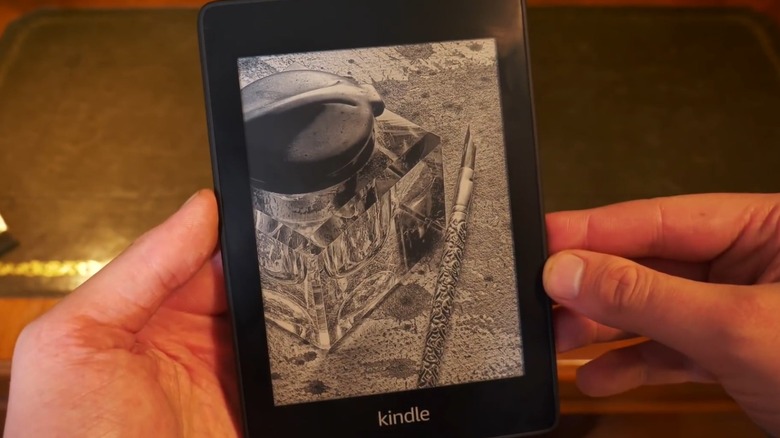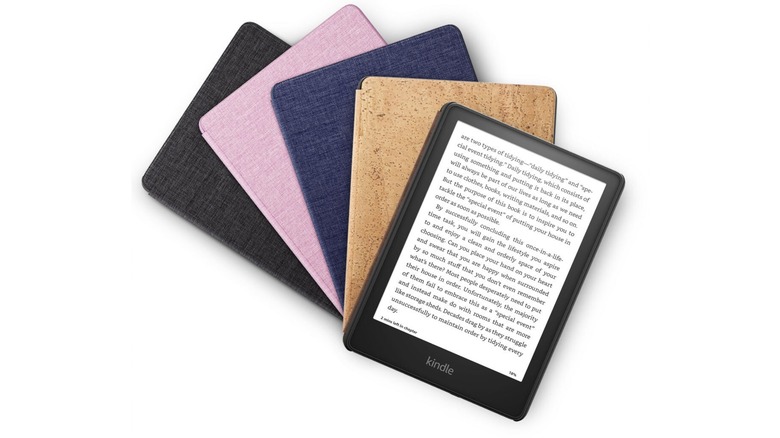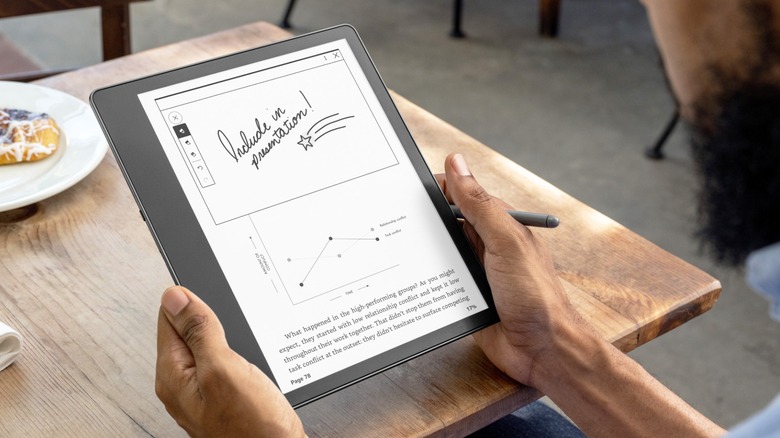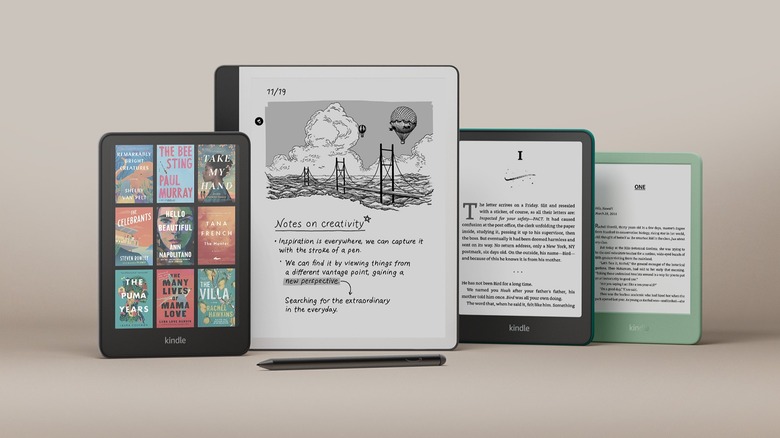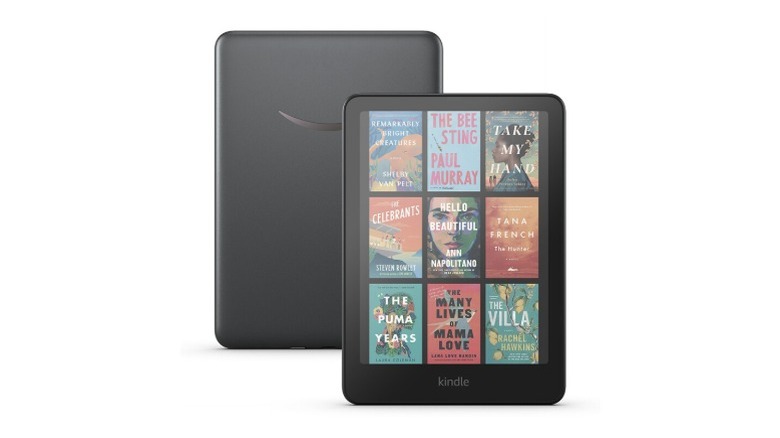The Evolution Of The Amazon Kindle From 2007 To 2025
We may receive a commission on purchases made from links.
E-readers have never become quite as ubiquitous as smartphones or tablets, but they still make up a decent chunk of the consumer electronics world, amounting to a $6.2 billion market (in 2023) and expected to double to $13.5 billion over the next decade. The undoubted leading name in this steadily growing market is Amazon, thanks to its Kindle devices. Kindle e-readers command an estimated 80% of the market, leaving non-Kindle e-readers from rivals like Kobo and Nook in the dust.
This isn't to say that Kindle devices are the be-all-end-all of e-readers, mind you, and e-readers like the Onyx Boox Tab X and Kobo Sage are genuinely great products that acquit themselves well against Amazon's offerings. Despite that, it's impossible to deny that Kindle e-readers are some of the best tablets for reading e-books and, thanks to Amazon's strong e-book ecosystem, have given Amazon a significant stranglehold on the market. And so, as we near the 20th anniversary of this game-changing e-reader, let's look back at all 12 generations of the Kindle, from its clunky first generation to the color- and note-taking e-readers of today.
Kindle 1 (2007)
It may seem hard to believe now, but not everyone thought the first-generation Kindle Amazon announced in 2007 would be a hit. The product of a three-year development cycle, the first-ever Kindle launched at $399 to some doubt from the media about whether it could truly replace printed books. And we don't entirely blame them: 2007 was a different time, and e-books weren't nearly as common a part of the consumer landscape as they are now.
The first-generation Kindle was also a bit ugly, which probably didn't help. Compared to Sony's sleek and surprisingly modern-looking Reader devices, which had already been out for around a year, the Kindle looked awkward and even a bit old-fashioned. It was large and wedge-shaped, with a physical keyboard and dedicated controls for scrolling and turning pages. Times were different, admittedly, but it sure didn't look like the future of digital books.
None of that mattered, of course. The Kindle sold out in five hours — likely thanks to the appeal of Amazon's 3G-powered Whispernet, which let users download books wirelessly — and Amazon had a winner on its hands. That said, we're unsure if anyone knew just how much of a winner the Kindle would prove to be.
Kindle 2 (2009)
Amazon unveiled the Kindle 2 in February 2009, retaining everything that made the original the best-selling product on Amazon, but boasting a slimmer form factor and massively updated hardware. The Kindle 2 had better battery life, a faster processor, 2GB of storage (up from 256GB), and an updated e-ink screen that could now show 16 shades of gray, up from just four in the first-gen Kindle. It was also slightly cheaper, at $359.
Amazon also improved the EVDO wireless Whispernet system on the Kindle 2, allowing the device to connect to Sprint's slower 1XRTT network instead of being limited to Sprint's 3G network. Amazon made other minor tweaks to the hardware design, including adding speakers for the new text-to-speech feature introduced alongside the Kindle 2 and switching to a non-removable battery.
May 2009 saw Amazon unveil the Kindle DX, which had a larger 9.7-inch screen and an auto-rotate functionality. Amazon seems to have targeted the DX toward magazine and newspaper readers, with The New York Times and Washington Post coming to the DX later that year. The larger screen came at a cost, though, with the DX retailing at $489 — just over $700 in today's money.
Kindle Keyboard (2010)
The previous two Kindles may have sold like hotcakes, but Amazon didn't rest on its laurels. In 2010, the Seattle corporation introduced the third-generation Kindle, called the Kindle Keyboard. The Kindle Keyboard was even sleeker than its predecessors, with the body now 21% smaller and 15% lighter than before. There was more to the third-gen Kindle than a new body, though, as this newly-svelte casing housed a redesigned keyboard with a five-way controller, an even higher-contrast e-ink display, and a Wi-Fi modem.
Reviews of the time praised the new e-ink screen, with the better contrast perfectly complementing software-side updates that offered more font size and line spacing choices. Amazon also dropped the price of the new Kindle down to an impressive $189 for the 3G-equipped Kindle Keyboard, with the Wi-Fi-only version coming in at $139.
The hardware upgrades and better pricing were enough to make the Kindle Keyboard the best-selling product on Amazon by the end of the year. The third-gen Kindle was the first to introduce the now-ubiquitous ads, too, when AT&T partnered with Amazon in 2011 to offer an ad-supported version of the 3G model. This ad-supported Kindle Keyboard brought 3G connectivity down to $139, the same as the Wi-Fi-only model.
Kindle Touch (2011)
2011 was a big year for Amazon and its Kindle devices. Amazon introduced four new Kindle devices this year, bringing new features and dropping prices below $100 for the first time in the e-reader's history. The basic Kindle, which had finally eliminated the keyboard in lieu of a five-way joystick and physical buttons, came in at $79, but the big deal was the $99 Kindle Touch — $179 for a 3G-equipped version — and its touch-capable e-ink screen. No physical buttons here — turning pages, scrolling, and taking notes were all done via touch.
The Kindle Touch also marked the debut of Amazon's X-Ray feature. Like X-Ray on Amazon Music, the Kindle Touch's X-Ray feature bolstered the consuming experience, this time by allowing readers to bring up word definitions from Wikipedia and Shelfari. Reviewers unsurprisingly loved the Kindle Touch, with some outlets calling it Amazon's best Kindle yet.
But there was a catch, of course: Amazon marketed the ad-supported versions as standard, and those who wanted an ad-free Kindle experience had to cough up an extra $30 or $40.
Also, it's a bit out of our purview for this article, but Amazon debuted the Kindle Fire tablet in 2011, launching a family of tablets that continues to this day in the form of budget-friendly tablets like the 2023 Amazon Fire HD 10.
Kindle Paperwhite (2012)
Amazon called the Kindle Paperwhite "the most advanced e-reader ever constructed" when it debuted in 2012. The e-reader offered the biggest leap for the Kindle's display users had seen up until then. Not only did it have a sharper 212-ppi display, but the Paperwhite now had a built-in front light, allowing users to read in all lighting conditions.
Amazon backed this new display tech up with new software features like Time to Read, eight weeks of battery life, and an even slimmer body, and reviewers loved it. Amazon also expanded its Whispersync library syncing so that users could alternate between text and audio of the same book. The lack of audio output on the Kindle meant that users had to use Audible — one of the many companies Amazon acquired in the 2000s — on a phone or tablet for the latter, though.
As had become usual, Amazon sold a Wi-Fi-only Paperwhite for $119 and a 3G-capable version for $179. The base Kindle also received an update for the fifth generation, with further reduced dimensions, a faster processor, and an even lower $69 base price. It was also black, differentiating it from the graphite fourth-generation Kindle.
Kindle Paperwhite 2 (2013)
Amazon kept its yearly update cadence up in 2013 by introducing the Kindle Paperwhite 2, the sole member of the Kindle's sixth generation. The Paperwhite 2 was an iterative update, focusing on software and hardware improvements without trying to change the already dominant Paperwhite too much.
Changes included a faster processor, a higher-contrast e-ink display (which also refreshed less frequently), and an updated front light that lit up the display more consistently. Amazon also tightened the touch grid, supposedly allowing for better response to user input. Hardware updates were just half of the story, though: Amazon also made several notable updates on the software side as well. A new feature called Kindle Flip allowed users to quickly flip back and forth between pages as they could with physical books, while Goodreads integration opened up the social side of reading.
In-line footnote support, a vocabulary builder, and an enhanced word look-up feature also debuted in 2013, while parents also got a boon in the form of Kindle FreeTime, which allowed parents to keep track of and reward their kids' reading. The basic Paperwhite's price remained the same, while the 3G-equipped version was now $189.
Kindle Voyage (2014)
The seventh generation of the Kindle kicked off in 2014 with a new model, the Voyage, alongside a new touch-capable basic Kindle. The latter was an evolutionary update, bringing an infrared touch screen, more storage, and a new processor to the entry-level product.
Compared to the seventh-generation basic Kindle, the Voyage was a more notable step forward. The most significant update was a new 300-ppi E-Ink Carta screen with an auto-adjusting front light, up from the 212-ppi of the Paperwhite. Amazon also introduced a flat glass front — no more recessed screens — and a magnesium shell, while the thickness dropped to an impressive 0.3 inches vs. the Paperwhite 2's 0.36 inches. These features unsurprisingly led to a higher price, with Amazon asking $199 for the premium e-reader.
E-book fans who didn't want to pay $199 didn't have to live without the 300-ppi screen for long, though: Amazon released a minor Kindle Paperwhite update in 2015, retaining the Paperwhite 2's pricing and hardware, but with the Voyage's 300-ppi screen in place of the old one.
Kindle Oasis (2016)
After the Voyage came the Oasis, another new introduction to the Kindle family in the mid-2010s. The eighth-generation Kindle Oasis was an even more premium offering than the Voyage, with the 2016 model sporting an all-new design that set it apart from older Kindles.
The most notable aspect was the stepped, two-tier back on the Oasis. The thin side was only 0.13 inches thick, while the more substantial side held the battery and was perfect for gripping when reading. The thinner body and materials allowed Amazon to reduce the Oasis' weight to an impressive 4.6 ounces without the cover (or 7.36 ounces with the cover attached). The e-ink display was the same 300-ppi unit as the Voyage and 2015 Paperwhite, but Amazon added more LEDs to the front light for more consistent lighting.
Amazon preempted any battery life issues from the thinner design with the included leather cover, which packed a second battery. This dual-battery setup allegedly made for months of uptime without charging. This goodness came at a hefty price, though, with the Oasis costing $289.99.
Kindle Oasis 2 (2017)
Amazon stuck with six-inch screens for the Kindle well into the 2010s, even as competitors like Kobo pushed the envelope with larger 6.8-inch displays on models like the Kobo Aura HD. Sure, it had the 9.7-inch Kindle DX, but that was long discontinued by 2017. So it was probably not a huge surprise when the Kindle Oasis 2 debuted boasting a larger display than its predecessor.
As you might expect for a follow-up to a premium e-reader, Amazon pushed the boat out even further on the Oasis 2 — and we don't just say that because it was now IPX8 waterproof (the first-ever waterproof Kindle). The highlight was undoubtedly the new seven-inch, 300-ppi display, which was as dense as the previous model but offered an extra inch of diagonal space for text. The screen wasn't the only new feature, either: Amazon finally brought Bluetooth support to its e-readers, so owners could listen to Audible audiobooks directly on the Oasis 2 via Bluetooth headphones or speakers.
Amazon also started offering more storage, with 8GB and 32GB models available. The only thing that didn't increase was the price, with the ad-supported 8GB Oasis 2 slightly cheaper than its predecessor at $249.99.
Kindle Paperwhite 4 (2018)
After focusing primarily on the high-end market with two consecutive Kindle Oasis models, Amazon returned to the mid-range with a new Paperwhite for 2018. This Paperwhite led the 10th generation of Kindles, standing out from its predecessors with some welcome features trickling down from the higher-end models.
The most notable of these was a new design that was thinner and lighter, with a Voyage-style flat front. From the Oasis, the 2018 Paperwhite inherited IPX8 waterproofing and Bluetooth connectivity, complete with access to the Audible store. Storage options also mirrored the flagship Kindle: 8GB and 32GB models were now available, with the former starting at $129.99.
But the Paperwhite wasn't the only model receiving some love in the 10th generation. Amazon also updated the basic Kindle in 2019, introducing adjustable front lighting, a capacitive — instead of infrared — touch screen, Bluetooth, and more storage. The Kindle Kids debuted in 2019 as well, bundling an ad-free 10th-gen Kindle (normally $89.99) with a cute cover, a year-long warranty, and a year's worth of Amazon Kids+ at $109.99. The final update for this generation was the 2019 Oasis, which could now adjust the screen's color temperature for nighttime reading — although the benefits of such a feature are now somewhat uncertain.
Kindle Paperwhite 5 and Paperwhite Signature Edition (2021)
The 11th generation of the Kindle was one of the most notable generations since the fourth generation, primarily for the new products Amazon added to the Kindle family. First up in 2021 were a larger, 6.8-inch Kindle Paperwhite and the new-for-2021 Kindle Paperwhite Signature Edition.
The headline feature on both was the new 300-ppi, 6.8-inch e-ink display, which also came with warm lighting and a dark mode. Amazon also updated the processor inside both, promising 20% faster page turns than the previous Paperwhite models. The Signature Edition, which cost $189.99 vs. the new standard Paperwhite's $139.99, added auto-brightness, 32GB storage, and the first-ever wireless charging support on a Kindle.
Amazon also introduced a Kids version of the Paperwhite in 2021. This followed the Kindle Kids model, adding a protective case, a two-year warranty, and a year's subscription to Amazon Kids+ to the Paperwhite. The 2024 Kindle Kids is also technically an 11th-generation model, even though it launched alongside 12th-gen products.
Kindle Scribe (2022)
One of the more notable e-reader developments of the 2020s was the push into larger note-taking devices that straddled the tablet and e-reader worlds. Kobo beat Amazon to the post with the Kobo Elipsa, a 10.3-inch e-ink tablet with stylus support, but the Seattle giant followed soon after with the Kindle Scribe — arguably the most notable model of the 11th-generation Kindles.
Like the Kobo, the Amazon Kindle Scribe was a 10.2-inch e-ink tablet with writing support. The 300-ppi display, like Amazon's recent Kindles, was a Paperwhite unit with an auto-adjusting front light and a coating that attempted to replicate the tactile feel of writing on paper. Pen-wise, Amazon shipped the Scribe with either a Basic or Premium pen, the latter of which had a dedicated eraser. Both pens attached to the Scribe magnetically and charged automatically, like the second-generation Apple Pencil. Despite the similar hardware to rivals, Amazon's note-taking Kindle undercut its rivals with a $339 starting price, likely thanks to Amazon's willingness to use Kindles as loss leaders.
But while the hardware was solid and well-received, the software wasn't quite as stellar. Initial reviews noted the Scribe's inability to mark up books and awkward PDF handling as downsides, although the former has improved greatly thanks to software updates — as shown in our review of the Kindle Scribe from 2023.
Kindle 12th generation (2024)
Now we come to the latest generation of Kindle devices, the 12th. As with the previous generation, we'll discuss the updated models here and leave the brand-new offering for later. The now-$399.99 Scribe got a new Premium pen for 2024, but the most notable improvement was likely Active Canvas. This software update — also eventually available on the 2022 Scribe — let users scribble in e-book margins and have the text wrap around their notes, addressing reviewers' biggest complaint about the first-gen Scribe.
As had become the norm, the best-selling Paperwhite also received an update. The 2024 Amazon Kindle Paperwhite had a faster processor, a thinner body, 16GB of storage, and a new, high-contrast, 7-inch screen, with a small price increase to $159.99 to go along with the improvements. A new Amazon Paperwhite Kids — not to be confused with the 11th-gen Kindle Kids — also debuted in 2024, sticking to the formula of a bundling child-friendly cover and six months of Amazon Kids+ with a standard Kindle Paperwhite.
Finally, the basic Amazon Kindle received a 300-ppi screen, better processor, brighter front light, 16GB of storage, and a new eye-catching matcha color. Like the other updated models, the Kindle 12's price increased slightly, with the ad-supported version now costing $109.99.
Kindle Colorsoft (2024)
The past couple of years have seen all the major names release color e-readers: The Onyx Book Tab Ultra C debuted in 2023, Kobo announced the Libra Color and Clara Color in April 2024, and Amazon the Amazon Kindle Colorsoft Signature Edition in October 2024.
Amazon's Kindle Colorsoft is basically the Paperwhite Signature Edition with a different e-ink screen. It has 32GB of storage and wireless charging but swaps the standard e-ink screen for a color-capable seven-inch display that runs at 300 or 150 ppi, the latter when viewing color content. Amazon claimed in its press release that it made some in-house adjustments to the color e-ink panel it used to offer better color and brightness than other color e-ink readers. Reviewers seem to agree, pointing out the Colorsoft's better color quality compared to competitors like the Kobo Libra Color.
This better color came at a cost, though: the Colorsoft debuted at $279.99, with reviewers generally ambivalent about whether the benefits of a color e-ink — and the reduced image quality in black and white — were worth the price premium.
